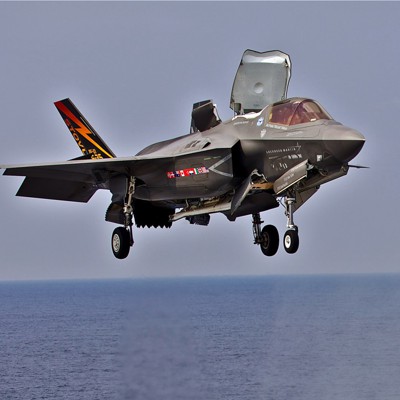Updated: 8:00 p.m. ET.
The Lightning II that crashed on Tuesday was one of very few F-35 developmental test aircraft, exacerbating a shortage that has in the past led to program delays.
The aircraft, which was en route from Lockheed’s facility in Fort Worth, Texas, to Edwards Air Force Base, California, crashed after a refueling stop at Kirtland Air Force Base, New Mexico. The F-35 was being flown by a Defense Contract Management Agency pilot, who was safely ejected was taken to a local hospital and is in stable condition.
“This was a U.S. government-owned-and-operated aircraft that was being flown by a government pilot who safely ejected. The aircraft was a test jet equipped with Technology Refresh 2 and was transferring to Edwards AFB for additional test equipment modification. Safety is our priority, and we will follow appropriate investigation protocols,” Lockheed said in a statement.
The F-35 that crashed was originally accepted by the government in September and was undergoing a modification to get more test equipment, the F-35 Joint Program Office said in a statement.
The loss of a test aircraft is bad news for the F-35 program, which is already strapped for testing capacity as it tries to finish a new hardware and software package for the jet, called Technology Refresh 3. Lawmakers added more test F-35s in the House Armed Services Committee’s version of the 2025 National Defense Authorization Act to help handle test and evaluation for the upcoming Block 4 upgrade.
The program has faced delays because of its small developmental testing fleet, according to a May report from the Government Accountability Office.
Testers “predicted that once software deliveries for TR-3 and Block 4 capabilities are back on schedule, the current testing fleet could face significant challenges in meeting testing demands,” the report said.
In a statement, Rep. Rob Wittman, R-Va., chairman of HASC’s tactical air and forces subcommittee, said, “While we know that expanding F-35 test capacity is the first step to fundamental F-35 transformation, this incident exacerbates the already urgent need to expand it. That’s why I authored an amendment in this year’s National Defense Authorization Act to increase F-35 test capacity by 50%, ensuring that the U.S. military can accelerate tests associated with our nation’s largest defense acquisition program. This incident will undoubtedly cause a technical setback for F-35 modernization and warrants an extensive and thorough investigation to determine the exact cause of this crash.”
Deliveries of new F-35s have been on hold since July because of software problems with the TR-3 upgrade. The new jets are stacking up at Lockheed’s facilities, waiting for TR-3 to be finished.
The jet that crashed on Tuesday was a short-takeoff-and-vertical-landing variant, which is operated by the Marine Corps. Social media posts show the aircraft taking off from the airfield and crashing soon after into a hill but the cause of the crash is unknown at this time.
Another Marine Corps F-35B crashed in September. The jet went missing near Charleston, South Carolina after the pilot ejected safely and the plane kept flying for 60 miles. Authorities eventually found the jet’s debris two hours’ drive northeast of Joint Base Charleston.
While the exact cost of the aircraft varies, the average flyaway cost of a new Marine Corps F-35 is $109 million, according to JPO.
Read the full article here


:quality(70)/cloudfront-us-east-1.images.arcpublishing.com/archetype/4GZN5XU6CFHAPGLQKQBU4ZHVKU.jpg)
:quality(70)/cloudfront-us-east-1.images.arcpublishing.com/archetype/OBBWXKC2HVH35HRVXGI6OTEN24.jpg)


:quality(70)/cloudfront-us-east-1.images.arcpublishing.com/archetype/L7J77CMOA5AT7EQPFKFKHH474Y.jpg)
Leave a Reply